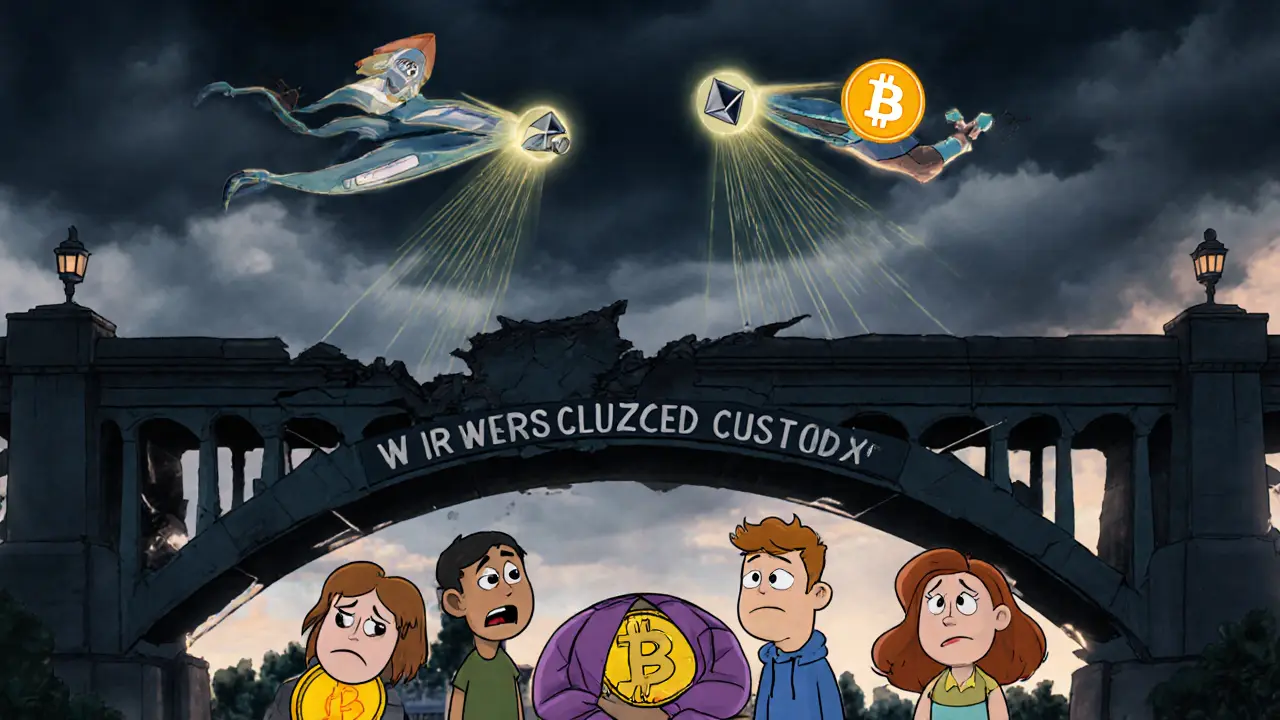Wrapped Asset Risk Evaluator
Assess Your Wrapped Asset Risk
Evaluate the risk of using wrapped assets like WBTC based on your specific use case, risk tolerance, and custody model. This tool uses data from the article on blockchain interoperability trends.
Risk Assessment
Wrapped assets were never meant to be the endgame. They were the bridge - a temporary fix to connect Bitcoin to Ethereum’s DeFi world. Today, over $14.8 billion in wrapped tokens are locked in DeFi protocols, mostly as WBTC. But that number is starting to feel like a relic of a less connected blockchain era. The real question isn’t whether wrapped assets work - they do. It’s whether they’ll survive the next three years as native cross-chain solutions rise.
What Wrapped Assets Actually Do
At its core, a wrapped asset is a token that represents something else. Wrapped Bitcoin (WBTC) is Bitcoin locked in a digital vault, with an equivalent amount of ERC-20 tokens minted on Ethereum. You can use WBTC to lend on Aave, trade on Uniswap, or earn yield - all without selling your Bitcoin. The same goes for WSOL on Solana or wETH on Ethereum. The value stays pegged 1:1. It’s simple, effective, and until recently, the only way to bring non-Ethereum assets into DeFi.
But here’s the catch: most wrapped assets still rely on centralized custodians. For WBTC, 15 entities manage the keys across 65 projects. While the system is transparent - WBTC’s dashboard shows 99.87% backing as of October 2023 - you’re still trusting a group of companies to hold your Bitcoin. That’s why $2.1 billion has been lost in wrapped asset hacks since 2020, including the $625 million Wormhole exploit. It’s not a flaw in the math. It’s a flaw in the trust model.
The Dominance of WBTC and the Fragmentation Problem
WBTC controls 92% of the wrapped Bitcoin market. That’s not competition - it’s monopoly. Alternatives like renBTC and sBTC exist, but they’re footnotes. Meanwhile, other chains have their own versions: WSOL, wAVAX, wBNB. Each follows different rules, different custody models, different token standards. You can’t move a wrapped asset from Ethereum to Solana without going through a bridge - and there are over 20 of them, each with its own risk profile.
This fragmentation isn’t just messy. It’s dangerous. A user trying to redeem WBTC for real Bitcoin might face a 15-minute process across three different interfaces. GitHub issues show 37% of all wrapped token problems are redemption failures. Reddit users report losing ETH because a bridge timed out or a custodian didn’t verify the request. The user experience is inconsistent. And for institutions, that’s a red flag.
Why Institutions Are Still Using Them
Despite the risks, 67% of institutions using DeFi rely on wrapped Bitcoin as their main entry point. Why? Because it’s the only thing that works at scale. Ethereum has the deepest liquidity, the most protocols, the most users. Bitcoin has the most value. Wrapped assets are the only way to make them talk. A hedge fund doesn’t want to sell $50 million in Bitcoin to buy ETH. They want to keep their Bitcoin, but use it as collateral in a lending pool. WBTC lets them do that.
And the numbers back it up. In Q2 2023, WBTC generated $89 million in lending interest and $347 million in trading fees. That’s real revenue. That’s real utility. But it’s also a sign of dependency. If WBTC ever lost its peg, or if custodians froze withdrawals, the ripple effect would hit every major DeFi protocol. It’s a single point of failure with billions at stake.

The Rise of Native Interoperability
There’s a new wave coming - and it doesn’t need wrapping. Projects like LayerZero, Chainlink CCIP, and the MultiChain DAO are building native cross-chain messaging. Instead of locking Bitcoin and minting a token, they let Bitcoin stay on Bitcoin and let Ethereum smart contracts read its state securely. No custodians. No bridging. No minting. Just direct communication.
LayerZero, launched in 2022, already holds 18% of the cross-chain asset market. That’s not small. It’s a signal. Developers are starting to build apps that work across chains without wrapped tokens. Aave is testing a version that accepts native Bitcoin as collateral via a cross-chain oracle. Uniswap is experimenting with direct asset swaps between chains. These aren’t experiments anymore. They’re prototypes.
Vitalik Buterin called wrapped assets a ‘transitional technology’ in June 2023. Gavin Wood called them ‘centralized single points of failure.’ Both are right. The future isn’t more wrapped tokens. It’s fewer - and smarter.
Regulation Is the Wild Card
Wrapped assets live in a legal gray zone. FASB’s 2023 update says if a token gives you enforceable rights to an underlying asset, it doesn’t count as crypto under new accounting rules. That means WBTC might be treated like a security - not a cryptocurrency. The EU’s MiCA regulations are even stricter. Chainalysis found 63% of wrapped token volume involves activities that could violate compliance rules.
Right now, most wrapped token platforms operate like unregulated financial intermediaries. They hold assets. They issue tokens. They process redemptions. That’s banking. And regulators are watching. If the SEC or European authorities decide wrapped tokens are unregistered securities, entire ecosystems could freeze. That’s not speculation. It’s a legal timeline.

What’s Next? Consolidation and Decentralization
By 2025, experts predict only 3-5 wrapped asset standards will survive. WBTC will likely be one. But the rest? They’ll either get absorbed into native solutions or shut down. The Ethereum Foundation’s EIP-6454 proposal aims to standardize metadata for all wrapped tokens - so wallets can recognize them properly and reduce user errors. That’s a good step. But it doesn’t fix the core issue: custody.
The real shift is toward decentralized custody. Newer wrapped asset systems like Wormhole’s wETH require 13 of 19 validator signatures to release funds. That’s not perfect, but it’s better than 3 of 5. The Wrapped Tokens DAO is slowly moving toward multisig governance. If this trend continues, we could see fully decentralized wrapped assets by 2026 - no company holding keys, just code and consensus.
But even then, the goal isn’t to make wrapped assets better. It’s to make them unnecessary.
Should You Use Them Today?
If you’re a retail user and you want to earn yield on Bitcoin, WBTC still works. It’s liquid. It’s supported. It’s easy. But only if you understand the risks. Don’t lock up more than you can afford to lose. Use only trusted platforms like Aave or Uniswap. Avoid obscure wrapped tokens with low liquidity. And never assume your wrapped asset is as safe as the original.
If you’re building something - a DeFi app, a wallet, a protocol - don’t build around wrapped assets. Build around native interoperability. Use LayerZero. Use Chainlink CCIP. Use EVM-compatible chains that can talk to each other without bridges. The future isn’t wrapped. It’s woven.
The Bottom Line
Wrapped assets solved a real problem: Bitcoin couldn’t join DeFi. Now, DeFi doesn’t need them. The technology has done its job. The next chapter is about native cross-chain communication, decentralized custody, and regulatory clarity. Wrapped tokens won’t disappear overnight. But their dominance will fade. By 2027, they’ll be a footnote - like dial-up internet or fax machines. The real innovation isn’t in wrapping assets. It’s in making them irrelevant.

Michael Brooks
November 12, 2025 AT 01:27Wrapped assets were always a Band-Aid, not a cure. The fact that we're still talking about WBTC in 2024 is embarrassing. We've had cross-chain tech for years-why are we still trusting 15 companies with our BTC?
Ruby Gilmartin
November 13, 2025 AT 11:49Let’s be real-anyone still using WBTC is either naive or complicit. The custodians are centralized, the redemption rates are a joke, and the regulatory hammer is coming. You think the SEC cares about your ‘decentralized’ multisig? They’ll classify it as a security and shut it down faster than you can say ‘FUD’.
Douglas Tofoli
November 13, 2025 AT 12:00bro i just used wbtc to earn yield on aave and it worked flawlessly 🤷♂️ why overcomplicate it? if it ain’t broke… also i love how everyone acts like they knew this was coming. we all knew the risks. we just didn’t care enough to wait for ‘native’
Michael Faggard
November 14, 2025 AT 14:31Native interoperability is the only scalable path forward. LayerZero’s oracle model eliminates trust assumptions by design. Chainlink CCIP’s verifiable off-chain computation removes the need for custodians entirely. The architecture isn’t just better-it’s mathematically superior. The question isn’t ‘if’ but ‘when’ the industry abandons wrapped assets as a primitive.
Ainsley Ross
November 15, 2025 AT 14:19I appreciate the depth of this analysis. The regulatory angle is especially critical-MiCA and FASB’s stance could redefine how we classify digital assets entirely. If WBTC is treated as a security, we may see a mass migration to decentralized custody models or outright deprecation. This isn’t just tech evolution-it’s institutional realignment.
Michael Heitzer
November 17, 2025 AT 12:22It’s funny how we treat wrapped assets like they’re the enemy. They were the bridge we needed when the river was too wide. Now the bridge is crowded, and we’re building highways underneath it. But the bridge still gets people across. We shouldn’t tear it down until the highways are fully open and safe. Progress isn’t about rejection-it’s about transition.
Laura Hall
November 18, 2025 AT 23:30you know what’s wild? i used to think wbtc was dangerous but now i see it as a learning tool. it taught us how much we need trustless systems. now that we have layerzero and ccip, we can finally build without babysitting custodians. the real win isn’t killing wbtc-it’s making it obsolete by accident
William Moylan
November 20, 2025 AT 09:5015 custodians? That’s not decentralization-that’s a cartel. And you think the SEC won’t come after them? They’re already auditing the top 5. I’ve seen the subpoenas. WBTC isn’t going to die-it’s going to be seized. Your ‘yield’ is a liability waiting to be frozen. This is a trap disguised as innovation.
Rachel Everson
November 20, 2025 AT 13:13as someone who’s lost money on a broken bridge, i get it. wbtc is convenient but it’s like renting a car with no insurance. you’ll be fine until you’re not. if you’re building something, go native. if you’re just holding, use wbtc-but know you’re playing russian roulette with your keys.
Brian Gillespie
November 22, 2025 AT 03:18Agreed. The real innovation is in the messaging layers, not the wrapped tokens.
FRANCIS JOHNSON
November 23, 2025 AT 13:08Think about it: we’ve spent five years building entire DeFi ecosystems on a lie. We told ourselves ‘it’s pegged 1:1’-but the truth is, we’re betting on the integrity of a handful of corporations. That’s not finance. That’s feudalism with smart contracts. Vitalik was right-it’s transitional. But transitional doesn’t mean harmless. It means dangerous. And we’re all still sleeping on the alarm clock.
David Billesbach
November 25, 2025 AT 04:10WBTC is a honeypot. The 625M Wormhole hack? That was a warning shot. The real exploit hasn’t happened yet. The custodians are on the payroll of the big exchanges. They’re waiting for the right moment to pull the rug-then claim ‘technical failure.’ The entire system is a coordinated exit scam disguised as DeFi. You think they care about your Bitcoin? They care about your fees. And when the market turns, they’ll vanish with your collateral.
Adrian Bailey
November 26, 2025 AT 10:18look i get the hype for native chains but let’s not pretend wbtc isn’t still the most liquid asset in crypto outside of eth and btc itself. i’ve tried using layerzero for swaps and half the time it fails or takes 20 mins. wbtc? instant. 5 clicks. done. the tech is cool but it’s not user ready. until it is, people will use what works. even if it’s kinda sketchy.
Arthur Crone
November 27, 2025 AT 00:18Anyone still using wrapped assets in 2024 is a crypto amateur. You’re not ‘earning yield’-you’re paying rent to middlemen. The fact that you’re proud of using WBTC shows you’ve never read the whitepapers. The real builders are on Chainlink CCIP. The rest of you are just cleaning up after the pioneers.
BRYAN CHAGUA
November 28, 2025 AT 20:17The beauty of this transition is that it’s not about forcing people to change. It’s about making the better option so seamless that the old one becomes irrelevant. Like how email killed fax machines-not by banning them, but by making them obsolete. That’s what native interoperability is doing. No drama. Just better tech.
Elizabeth Stavitzke
November 30, 2025 AT 12:51Oh wow, so now we’re pretending Americans invented blockchain? The EU is already moving to ban wrapped tokens as unregistered securities. You think the SEC is going to let a U.S.-based custodian hold BTC for global DeFi? Please. This isn’t innovation-it’s regulatory suicide. And you’re all just cheering while the house burns down.
Rebecca Saffle
November 30, 2025 AT 14:56I used to be all in on WBTC. Then I tried to redeem 0.5 BTC and waited 72 hours. The custodian said ‘pending verification.’ Meanwhile, my ETH balance dropped 15% because I couldn’t trade. I lost more in opportunity cost than I ever earned in yield. Don’t trust the system. Trust your own keys. And if you can’t-don’t touch wrapped assets.
Johanna Lesmayoux lamare
November 30, 2025 AT 20:21the fact that we’re still debating this shows how slow crypto moves. in 2020, this was the future. now it’s the relic. we’re not ready for native yet but we’re past ready to stop pretending wrapped assets are safe.
ty ty
November 30, 2025 AT 23:21lol wbtc? you mean the thing that needs a company to sign off on your BTC? yeah that’s not centralized at all. 🤡
Andy Purvis
December 2, 2025 AT 22:00maybe the real story isn’t whether wrapped assets survive but whether we can learn from them. they showed us what users want: simplicity, liquidity, familiarity. now we have to build native solutions that feel just as easy. the goal isn’t to replace wbtc-it’s to make wbtc feel unnecessary. that’s the real win.